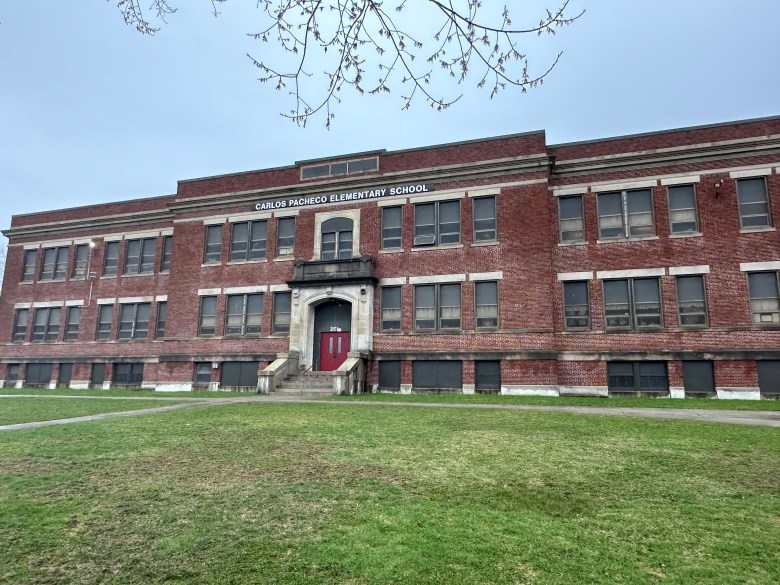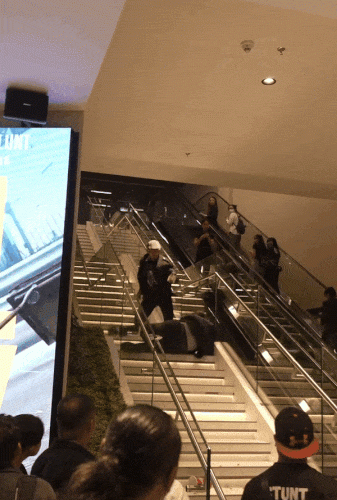
The New Bedford Public School District has quietly begun to talk about replacing the city’s 50-year-old high school, possibly even replacing it before it rebuilds the last two of its 100-plus-year-old elementary schools.
Superintendent Andrew O’Leary says it takes 10 years to plan a new school and now is the time to start talking about replacing the high school. With rapidly escalating construction costs of recent years, he predicted it could cost as much as $500 million.
The scenario could leave two West End elementary schools waiting — the Carlos Pacheco and the Betsey B. Winslow — for even longer than the high school. The Pacecho is located on the border of one of the lowest-income neighborhoods in the city.
I first got wind of the plan at a December City Council meeting when long-term Councilor Linda Morad said she had heard that the talk is now to go away from a 20-year-old plan by the late Mayor Fred Kalisz, first envisioned in 2001, to replace all 10 of the city’s 100-year-old elementary schools and upgrade the four 1970s-era elementary schools.
Brittany Hullinger, the New Bedford High School manager of operations, said determining which school most needs to be replaced is not simply a matter of age, but the nature of the facilities.
“It’s a priority list based on safety and immediacy of need,” said Hullinger. “Are those windows going to collapse completely? How do they rank against other windows? (It’s) less on the time period they exist.”

For the record, like most New Bedford elementary schools, Pacheco and Winslow have long suffered from the dim light of opaque replacement windows installed in the 1990s.
Hullinger, who has a background in museums among other building operations, spoke about the late Victorian-era elementary schools with their hardwood floors and marble work and their value. She explained that a newer building can sometimes have more problems than an older one.
O’Leary talked about how replacing the high school will serve more kids than replacing an elementary school.
The school administration, as well as Mayor Jon Mitchell, have long been concerned about the image of New Bedford High School. At one time, the majority of Acushnet high schoolers attended New Bedford High but now they go to Fairhaven. Recently, the news broke that New Bedford has the highest percentage of home-schooled students in the state.
O’Leary, and former Headmaster Bernadette Coelho before him, have made it their mission to celebrate the achievements of the school.

O’Leary acknowledged that students, when they encounter newer and better-equipped schools in other districts, are aware of the nature of the present high school and it has an effect on the way they think about their own worth.
“When my kids go to Durfee for a game, or go to Taunton for a game, they come back to me and say ‘Wow, they have beautiful classrooms and beautiful hallways and beautiful spaces. What’s up with that?,” he said.
“They give me a harder time than you about the buildings,” he told me, referencing my own longstanding concerns about how New Bedford has lagged behind other communities in replacing or upgrading its school buildings.
O’Leary, a Rochester resident, is not afraid to walk the walk. His two older sons attend the high school, and his two younger kids now plan on going to the high school, taking advantage of the more extensive opportunities a large school system like New Bedford can offer. Mayor Mitchell made the same commitment. Though he could clearly have afforded to send his three daughters to private schools, all three of them attended New Bedford High, the youngest a senior who plans on attending Harvard, like her father did, next year. She is one of four students this year who received early acceptance to Ivy League schools.
O’Leary’s building record
No one has done more than Superintendent O’Leary to address the circumstance of New Bedford having a higher percentage of outdated school buildings than any other community in the state. His background is in financial operations for the district and he has worked the grant funding pipeline for years.
Last year O’Leary lobbied both the Massachusetts School Building Authority and the media about inequities in the state’s school building funding system. I wrote about it extensively in a June 2023 column that outlined how New Bedford was judged to have 67% of its school in the “Worst” category for adequacy. The next highest school district for “Worst” was Holyoke, which only had 48% in that category.
O’Leary says that because the state has yet to fully address the equity issues in the MSBA’s funding process, New Bedford has to think about taking opportunities where easier, quicker money is available. It will have to build or renovate more expensive wholescale building projects later, or at least whenever the state makes a bigger commitment to post-industrial, lower-income communities like New Bedford.
That’s why New Bedford has prioritized spending for needed repairs and upgrades to the high school pool, auditorium, band room and weight room even as a big school building project was out of reach for the city.
In the past few years, the city spent $3.7 million on the high school cafeteria; $2.5 million on the pool; $200,000 on the planetarium and $50,000 on the library; and $10 million on HVAC systems and roofs at the Gomes and Pulaski schools.
Recent school building upgrades in New Bedford
These upgrades are either completed or in the works. Much of the cost to the city was reduced for these projects by state and federal funding.
- High school cafeteria: $3.7 million
- High school pool: $2.5 million
- High school health center: $3 million
- Central kitchen: $12 million
- HVAC and roof works at Gomes and Pulaski schools: $10 million
- Planned Hathaway School renovation: $9 million
- Planned High School health center: $3 million
- High school planetarium: $200,000
- High school library: $50,000
- Planned high school senior lounge: $100,000
- Other upgrades: $800,000
In the near future the district plans to spend $12 million on a new central kitchen building that will supply the many schools without their own full-service cafeterias, and $3 million on a high school health center. Much of this spending was facilitated by government loan programs that reduced the cost to the city.
O’Leary acknowledged that a building planning process must also begin for replacing or upgrading the last two century-old elementary schools, but he has not said whether the high school or the elementary projects — previously a part of Mayor Kalisz’s 20-year rebuilding plan — should go first. With the MSBA paying for two new elementary schools in the next five to seven years, it’s hard to envision how the city could build both a high school and two new elementary schools within 10 or even 15 years.
In the meantime, O’Leary and the current finances assistant superintendent, Barry Ravinovitch, have been concentrating on small building upgrades. Like the replacement of the dingy, opaque windows at the Gomes, Pulaski, Hayden-McFadden and Carney elementary schools, which have already been completed, and a planned $12 million upgrade at the half-century old Hathaway Elementary.
The New Bedford district has also applied for available roof replacement money for all the remaining elementary schools with the exception of Rodman, where the roof is in good shape and the student population may eventually be absorbed by the adjacent Hathaway and Carter-Brooks elementary. The reason? There is state funding available for it in the MSBA’s restoration of its school maintenance budget, partially due to O’Leary’s lobbying.
Meanwhile, modular classrooms have been a solution that school districts usually try to avoid, but New Bedford is in the process of planning them for Carter-Brooks and has long used them at both the Hathaway and Jireh Swift elementaries.
Finally, long-term, the New Bedford system will have to solve the problem of where to locate an expanding pre-K program and how to upgrade the buildings of both alternative high schools (Whaling City is located in the 100-year-old former County Street high school and Trinity Day Academy is in the 100-year-old former vocational high school on Hillman Street).
O’Leary noted that there is school infrastructure money in the Inflation Reduction Act for overhauling things like HVAC systems, and energy recovery units, electrical overhauls and geothermal energy systems. Those upgrades can apply to 1970s-built schools as well as 100-year-old ones. “Those are opportunities that we want to push for,” he said.
The district, he said, is applying for every government grant available — that is how it has already accomplished opaque window replacements, roof repairs and energy-saving upgrades in recent years.
“Those are the opportunities available. And I think as a district we’ve done more than most,” he said.
The building issues remain
Some New Bedford elementary schools, however, continue to have no shortage of unaddressed building issues.
At the Carlos Pacheco Elementary School off Hathaway Road in the northwest section of the city, the 2,900-square-foot auditorium is not usable as an auditorium. That’s because it’s divided up into teacher’s preparation and consulting areas.

At Rodman Elementary in the West End, there’s no gymnasium, so the kids waste valuable school-day time walking to the Boys and Girls Club gym a few blocks away.

At the Betsey B. Winslow, also in the West End, the stately brick school with the marble fixtures looks in decent shape. That is until you read the 2001 report prepared for the late Mayor Fred Kalisz describing the state of the ventilation system in the auditorium and the exhaust systems in the bathrooms.
Have they been fixed then? The opaque plastic windows haven’t.
Both the Pacheco and Winslow schools are valuable historical buildings that might be able to be renovated and updated. But they in no way are equipped with all the state-of-the-art accouterments for a 21st century education in terms of electrical wiring, teacher prep rooms, adequate gymnasiums, libraries, etc.

Meanwhile, the focus has been on making New Bedford High more attractive as its own facilities have aged out.
With aggressive grant chasing and creative management, the district has managed to do wonderful upgrades at the high school in recent years. It has spent millions repairing leaks to the pool, upgrading the acoustics in the auditorium and band room, and renovating the weight room, library and several ball fields. They say they are beginning to spend on increasing the library collection.






But the sprawling 1970s-era high school, built in the foreboding brutalist-style of architecture of that era, either needs an entirely new building or a complete rebuild for the latest generation of educational instruction. New Bedford is behind Fall River, Brockton, Dartmouth and Westport in replacing a 50-year-old structure.
In the column I wrote almost a year ago, O’Leary described a 2016 Massachusetts School Building Authority survey in which New Bedford far and away had the largest number of “worst” category schools. Besides Holyoke, there was only one other school system — Worcester —that came close to New Bedford in the number of its “worst” category buildings. But Worcester was far behind New Bedford’s 67% with 45% in that category.
Much has been made of the fact that next year, New Bedford will break ground to replace two of its 100-year-old elementary schools (the DeValles and Congdon). Two years after that school opens in 2026, the district hopes to replace two more 100-year-old elementaries (the Ashley and Swift), with a best-case opening date scenario in 2029.
But even after those schools are built, New Bedford will still not have addressed the renovations or new buildings needed at the Pacheco and Winslow schools.
The feeling seems to be that New Bedford is so far behind similar communities in replacing its school buildings that if it pushes the high school before the last of the elementary schools, it will be able to do the greatest good.
It’s not that New Bedford has not tried to serve the elementary kids. In 2001, the Mount Vernon Group prepared a 3 1⁄2-inch thick report analyzing the state of the elementary schools and the school administration building for then Mayor Kalisz.
Kalisz, more than any other mayor in recent New Bedford history, intended to address the long-neglected repair and replacing of the New Bedford elementary and middle schools.
He got halfway there, replacing the city’s three junior high schools with new (6-8 grade) middle schools, and he devised a plan to replace 10 100-year-old elementaries with eight new schools; upgrading the four 1970s-era elementaries at the same time.
After the debacle of the cost-overruns at the construction of the Keith Middle School on a PCB site, and the state, under former Gov. Mitt Romney, greatly reducing the money available for new schools in the newly created MSBA program, the replacement elementaries envisioned by Kalisz never got built.
Former Mayor Scott Lang got one of those elementaries built (the Lincoln) and added on to the Sea Lab to form a new Taylor, but the rest were left to the future. Twenty-three years later, they’re still not built.
During his 12 years as mayor, Jon Mitchell, weathering the Great Recession and an underfunded MSBA, only built one new school, the Hannigan — replacing Jacobs School (the Hannigan’s roof had collapsed so it was an emergency).
In my June 2023 article, I wrote about a suburban, white-district bias in the new schools financed by the MSBA over the last decade. I was not the only one writing about that — so was the Boston Globe.
O’Leary does not deny the challenge but says it’s nothing new, and he emphasizes that inequity is between the wealthier school districts and New Bedford, not the inequity within some city neighborhoods and others.
Here’s how he describes the below-par facilities in some elementary schools:
“They are living with those facilities. For the past 25, 30, 100 years. Yeah, absolutely,” he said.
The inadequate facilities at both the high school and remaining elementary schools have been a problem for a long, long time, O’Leary acknowledged. Some elementary schools have everything from a new library to contemporary gymnasiums and auditoriums, 21st century electrical and ventilation systems for computers while others do not.
Part of the problem, he said, is that the state makes it easier to build new vocational and charter schools through different funding and reimbursement systems. Part of it, however, is just that New Bedford has not replaced aging schools at the rate other communities have.

A future high school discussion
Still, New Bedford is already behind the nearby similar communities of Fall River and Brockton in replacing its high school building. New Bedford clearly needs to start the planning for the next high school or high schools, not to mention the elementary schools, now.
Newton, one of the most affluent communities in the state, with state funding built one of the five most expensive high schools ever constructed in America for $197 million in 2010. Arlington, with one of the best-educated populations in the state, is in the midst of constructing a $290 million new high school, all with state aid.
O’Leary said the inequities have been so disturbing to him that he has had to block an Arlington High School website on social media.
“If you go to the Arlington High School Facebook page, it’s like that scene when Leo and Kate are on the stairs in Titanic. Arlington High School is like that. They’ve got a stairs like that. It’s unbelievable,” he said.
So a big part of the solution to New Bedford’s school building problem is going to have to come from the state level. Surprisingly, the South Coast legislative delegation, however, does not currently have a member on the Legislature’s Joint Committee on Education.
All the members of the delegation I spoke with said they are committed to revamping the inequities in the funding system. But unless something happens soon, it will take a long time.
Mark Montigny last year sent me a note pointing out that last year’s Senate budget included an additional $100 million for the MSBA and increased its annual spending cap by $400 million.
But that’s a drop in the bucket that wouldn’t even solve New Bedford’s current school building needs, never mind the entire state’s.
Perhaps more importantly, Montigny’s plan would create a commission to review the authority’s financial capacity and funding formula to ensure greater equity.
Rep. Tony Cabral and Chris Hendricks, whose districts include the Pacheco and Winslow schools, said the MSBA formula clearly needs to be reformed.
Cabral said the funding formula “urgently” needs to be reformed and that he has spoken to O’Leary about doing just that.
“This is an issue for New Bedford and Gateway Cities across the Commonwealth; communities that have experienced historic underinvestment in education,” wrote Cabral, a former teacher, in a statement last year.
The activist group, Lawyers for Civil Rights, has questioned the MSBA system and O’Leary says it may be ripe for a lawsuit, similar to the one that led to education reform 30 years ago.
School building needs are by no means the only unmet ones in New Bedford. Whatever happens at the state level, building needs will have to compete with other underfunded public education needs in Massachusetts.
Joyce Cardoza, the newly appointed principal of New Bedford High School, noted that buildings are not the only priority for the city system. A one-time multilingual dropout prevention specialist, she said that there are important services that students need too.
“Per pupil, we’re trying to still allocate dollars toward counseling services” and other services students need, she said.
O’Leary agreed and stressed the ELL literacy services, for an immigrant population that he described as one of the city’s future great strengths.
“We got some initial criticism that our ESSER (federal pandemic relief) dollars were not targeted for high dosage tutoring and things like that,” he said. “They are targeted for the building and supplemental building projects like the kitchen, the school ESL center, and the Hathaway overhaul.”
With all the competing priorities, and the state’s funding system, the new or revamped building needs could take 10, 15, even 20 years before the high school and last two elementary schools are replaced, O’Leary admitted.
“I don’t think we should stop. I think we should take a breath,” he said. “And I think, give a lot of credit to The Light for outlining it. And now we need to say ‘What’s next?’”
According to O’Leary, a community’s investment in its school infrastructure is what the economy is for. He noted that when the 1910 and 1972 high schools were built, they were points of enormous pride illustrating the city’s commitment to its future.
“So it should actually be an exciting conversation as much as it is an equity conversation,” he said. “Look ahead the next 10 years or so and what does New Bedford want? That’s what Arlington did and that’s what Durfee did.”
Email Jack Spillane at [email protected].
More stories by Jack Spillane
The post New Bedford begins to look at new high school appeared first on The New Bedford Light.




